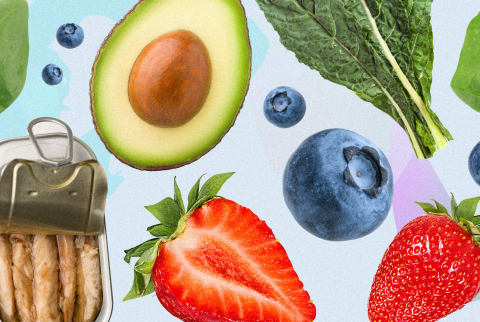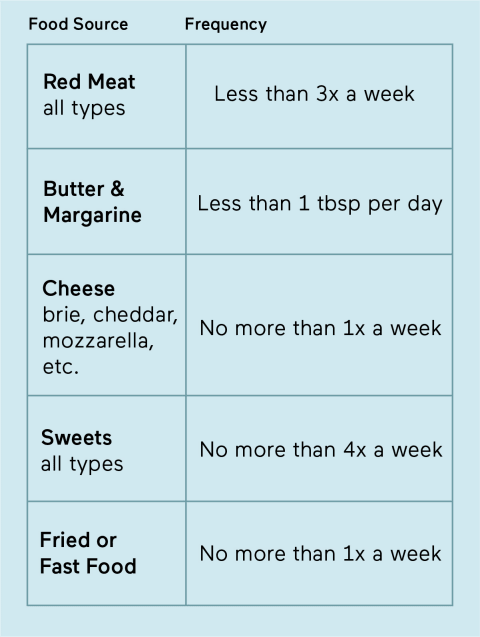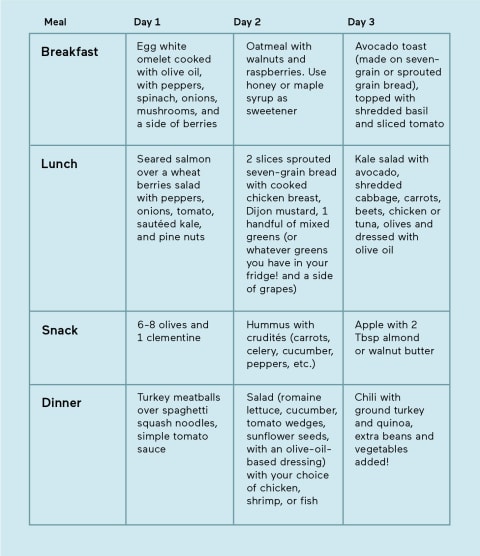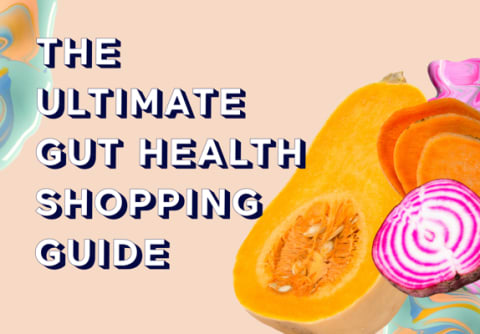Advertisement
MIND Diet: What Is It, Health Benefits & A Sample Meal Plan


You may have heard of the MIND diet, developed as an intervention to help reduce cognitive decline and fight against Alzheimer's and dementia.
Despite having benefits for our aging mind (Note the play on words here: It technically stands for the Mediterranean-DASH Intervention for Neurodegenerative Delay, but the health benefits are brain-heavy), it's not only limited to the aging population.
Scroll below to learn more about what the MIND diet is, the health benefits of this eating plan, and how you can begin following the diet today.
What is the MIND diet?
The Mediterranean diet is based on the traditional cuisine in the countries that border the Mediterranean Sea (it's frequently recommended by doctors, medical institutions and hospitals, and it was even voted No. 1 best diet for overall health according to U.S. News and World Report in 2022).
For a mini refresher on the Mediterranean diet, this plan is focused on plenty of antioxidant-rich vegetables, fruits, whole grains, beans, and sources of healthy fats from nuts, seeds, and avocado and olive oil.
When following the Mediterranean diet, you're encouraged to eat vegetables, fruits, whole grains, herbs, spices, and healthy fats daily, along with lean proteins such as fish and poultry; it's also recommended to cut back on red meat and dairy.
The MIND diet is also based on the DASH diet, which stands for Dietary Approaches to Stop Hypertension; this diet is geared toward lowering or controlling high blood pressure.
When following this diet, it's recommended to consume foods lower in sodium while increasing foods that are higher in other electrolytes, such as potassium, calcium, and magnesium.
This diet also emphasizes consuming more whole grains, vegetables and fruits, low-fat dairy, poultry and fish, and (similarly to the Mediterranean diet) recommends limiting dairy and red meat.
Summary
What makes the MIND diet different?
As mentioned, the MIND diet is a blend of the DASH and Mediterranean diets—while there are similarities between all three diets, the MIND diet has some key points that make it stand out.
For instance, while all vegetables are permitted on the MIND diet, it places emphasis on leafy green vegetables.
A few star veggies include spinach, kale, and collard greens, which have been found to be particularly beneficial for brain health due to their source of folate, vitamin E, and carotenoids.
Research suggests that one serving a day (1 cup of raw or ½ cup cooked) of these vegetables may slow brain aging2.
It's recommended to have six servings of greens a week on this diet, with the remaining vegetable intake coming primarily from nonstarchy vegetables like these:
- Asparagus
- Beets
- Brussels sprouts
- Broccoli
- Celery
- Eggplant
- Greens (collard, kale, mustard, turnip)
- Mushrooms
- Peppers
- Tomato
Another thing that makes the MIND diet stand out is its recommended fruit intake.
This diet emphasizes eating berries—specifically blueberries and strawberries—as the primary source of fruit and doesn't emphasize any other fruit.
The reason for the MIND diet's berry obsession? Studies have shown that individuals who ate the most berries had the slowest rates of cognitive decline3.
That said, the MIND diet suggests two or more servings of berries a week (perfect guidelines for a yummy antioxidant smoothie).
Nuts and fish are also staples of the MIND diet—nuts are an excellent source of vitamin E, which is a key nutrient for brain health.
The MIND diet recommends five servings per week of dry-roasted or unsalted nuts. Research suggests that one serving of fish a week may reduce cognitive decline4.
That research doesn't specify any type of fish, but the MIND diet suggests fish highest in omega-3 fatty acids, like salmon for instance.
Summary
What are the health benefits?
Many of the health benefits of the MIND diet stem from the nutrient-rich foods included in the plan.
The emphasis on so many fruits, vegetables, and lean proteins makes this diet a super-nutrient-packed eating plan in itself.
Anti-inflammatory benefits
The food components of the MIND diet contain a variety of anti-inflammatory compounds, including:
- Omega-3 fatty acids in fatty fish and walnuts
- Folate in green leafy vegetables
- Flavonoids in berries
- Vitamin E in nuts, avocados, and olive oil
- Polyphenols in olives and olive oil (both are major components of the MIND diet as their rich source of monounsaturated fatty acids)
Research also suggests that dark green vegetable and berry consumption may reduce inflammation and oxidative stress—two key components of Alzheimer's disease and cognitive decline.
Brain health benefits
The MIND Diet has been found to be associated with better cognitive performance and in some studies to prevent cognitive decline5 including the development of Alzheimer's disease.
Another study found that women who consume blueberries, strawberries, and blackberries may delay cognitive decline by up to two years3 (which only strengthens the reason the diet encourages berries, as previously mentioned).
Because the MIND diet is naturally low in saturated fat and cholesterol, it's also suggested to reduce the risk of dementia as well as Alzheimer's disease, which studies show is involved in the blood-brain barrier and is involved in the pathology of both diseases6.
Generally, the MIND diet also appears to reduce amyloid plaque production7 (which some research has found may be behind Alzheimer's).
Antioxidant-rich
As discussed, many of the foods on the MIND diet are high in antioxidants (like green leafy vegetables and brightly colored berries).
All vegetables contain healthy nutrients, but the richer in color, the more antioxidants, according to research.
Gut health benefits
Many of the foods on the MIND diet contain good sources of fiber, (nuts, seeds, fruits, and vegetables), which promote healthy digestion8 and a healthy gut microbiome overall.
Heart health benefits
Many of the components of the MIND diet contain heart-healthy properties—the nuts, seeds, avocado, and olives contain healthy monounsaturated fats, as well as the recommended amount of omega-3 fatty acids9.
Blood sugar benefits
Many of the foods included on the MIND diet contain great sources of fiber (as mentioned above) as well as healthy fats from both plant and animal-based protein—all properties that are great for balancing blood sugar.
Upon commencing the MIND diet, people may find that their blood sugar has improved due to the high-fiber, protein-packed, anti-inflammatory foods10.
Summary
How to follow the MIND diet
So, you understand the basics and science behind the MIND diet, but (like with most restrictive diets) actually following it is often the most difficult part.
Breaking the diet down into what foods you should include more of and how to combine them together can help you execute the diet in an easier way.
Here's a list of approved and prohibited foods (and how much you should eat).
Approved foods:
If you're starting your MIND diet, here are the foods you should make sure to include on your plate.
A note: These are the minimum servings to try to meet, especially for the vegetables. If you can include more veggies, that's always a good idea!

Foods to avoid:
Below are the foods you should try to avoid. Although the diet technically allows these five foods up to a certain number of times per week, it's best to avoid them entirely if you can.

Sample meal plan
Here's what a three-day meal plan on the MIND diet might look like:

The bottom line
I love this diet—it's a blend of two super nutrient-rich diets that boast anti-inflammatory, heart health, and brain health benefits.
The emphasis on fruits and vegetables, healthy fats, and less processed and refined foods is a great way for most of us to be eating every single day.
That said, any time you start a restrictive diet, it's always a good idea to check in with your doctor.
Here's to optimized brain and heart health—feel free to toast to good health with one glass of red wine as you dine with family and friends (a practice that's always Mediterranean-diet approved!)
10 Sources
- https://www.ncbi.nlm.nih.gov/pmc/articles/PMC5509411/
- https://www.ncbi.nlm.nih.gov/pubmed/29263222
- https://www.ncbi.nlm.nih.gov/pmc/articles/PMC3582325/
- https://www.ncbi.nlm.nih.gov/pmc/articles/PMC6855948/
- https://www.ncbi.nlm.nih.gov/pmc/articles/PMC6600544/
- https://www.ncbi.nlm.nih.gov/pubmed/24970568/
- https://www.ncbi.nlm.nih.gov/pubmed/27025652
- https://www.ncbi.nlm.nih.gov/pubmed/29902436
- https://ods.od.nih.gov/factsheets/Omega3FattyAcids-HealthProfessional/
- https://www.ncbi.nlm.nih.gov/pmc/articles/PMC4083349/
